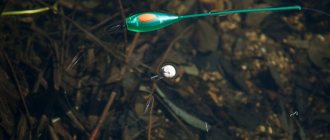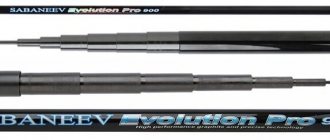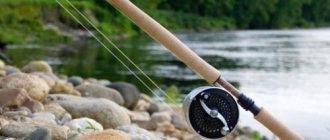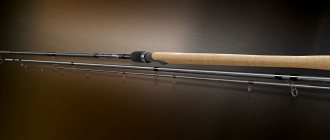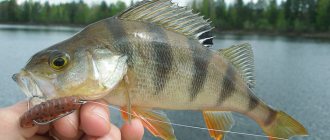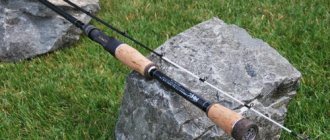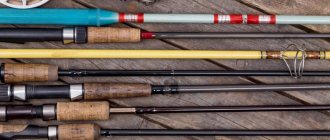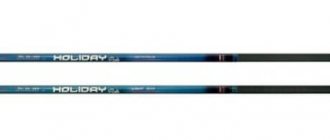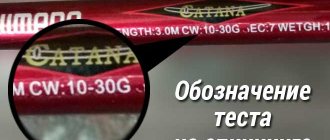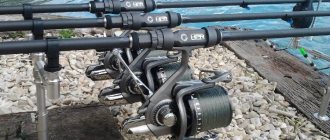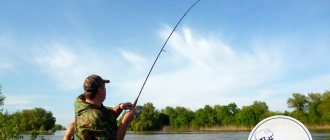Published: 04/11/2015
I will try to embrace the immensity...
The topic is very broad and complex, especially for novice fishermen. It is impossible to present everything in detail in one article, so I will make links to videos from feeder fishing experts and to my articles published on the website feederist.ru earlier, which outline some issues of feeder fishing in more detail.
First of all, I would advise novice fishermen to familiarize themselves with the excellent video material of Dmitry Salapin
In the future, for a more in-depth study of feeder fishing issues, I would recommend familiarizing yourself with the videos of Alexey Fadeev, Sergei Popov, Alexey Strashny, the Shcherbakov brothers and other athletes who popularized feeder fishing.
But let's get straight to the topic of our article. I would like to make a reservation right away: some of the questions stated below are not indisputable and the ultimate truth.
What is a feeder
Rods of this type are a strong and powerful rod used in fishing for casting heavy tackle over long distances from the shore.
For ease of transportation, feeder forms are manufactured in composite forms, with a telescopic or plug-in connection.
The material for their manufacture is fiberglass, but carbon fiber or composite materials are more often used.
The feeder rod needs power in order to cast heavy equipment. Its weight can reach 100 grams or more. However, it is not always appropriate to use such equipment. In small reservoirs it is more convenient to fish with short forms with light equipment. Such fishing rods, with a length of up to two meters, can be equipped with tackle weighing 20–40 grams. Such fishing rods are called “picker”, they are specially designed for small bodies of water.
The main external difference between a feeder rod and other types of blanks is the number of installed guide rings. It can reach 8–12 pieces and be located at a distance of 5–30 centimeters from each other.
The feeder rod is telescopic (on the left) and plug-in, complete with additional tips for various test indicators.
Bypass rings are made of materials with low friction properties and high wear resistance. Their purpose is to dampen transverse deviations of the cord (line) as it leaves the reel and passes through the channel formed by the rings. At the same time, resistance to movement is reduced significantly.
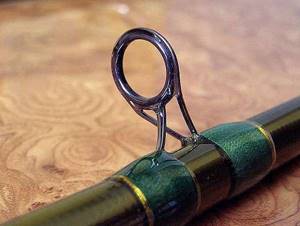
Feeder guide rings structurally ensure free passage of the cord when casting gear.
Taking into account the characteristics of the reservoir and the conditions of feeder fishing on it, you can choose a suitable form, taking into account the various requirements for it based on the following possibilities:
- light class (ligch),
- middle class (medium),
- heavy (heavi),
- extra heavy (extra heavi),
In addition, the market may offer intermediate options for rod classes, for example – medium – heavi.
When purchasing a feeder form, you need to find answers to the following questions:
- conditions of use, including the size and characteristics of the reservoir,
- weather and climatic features,
- own financial capabilities.
Obviously, the problem of choice for an inexperienced person is far from simple.
How to choose a feeder for a beginner
When choosing, we will clarify some parameters of fishing conditions and the applicability of rod classes depending on them: “Picker” rods with a length of 180–300 centimeters are used for fishing in small and medium-sized reservoirs with standing water or in slow currents. In this case, the casting range is up to 30 meters from the shore line. It is especially convenient to use such forms in poorly accessible places with abundant coastal vegetation. It is convenient to fish with them if you need to make a short cast at a distance of 15–20 meters. In this case, light equipment weighing 20–40 grams is used. But most often short pickers are used when fishing with small fish (breather, rudd, roach and others like that) using floating devices.
If hunting is carried out specifically for fish weighing up to 1.5 kilograms, it is better to use pickers up to three meters long. They can be thrown quite easily over a longer distance, and catching trophies is easy and simple.
The peculiarity of fishing with a feeder is the need to keep the fishing point constantly baited. When using a feeder, it takes a lot of time to reload it with bait, which significantly reduces the overall efficiency of fishing. Therefore, when fishing at a short distance, up to 40 meters, an ordinary weight is used instead of a feeder, and the bait is delivered to the point by hand, by catapult or other available methods.
With the advent of materials of increased strength, two-part pickers began to be manufactured with tests of 80–120 grams, which significantly expanded the scope of their application.
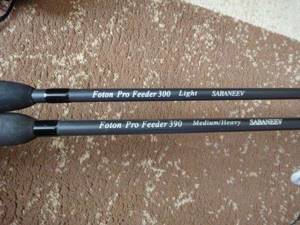
Types of pickers for feeder fishing.
Choosing a “light” feeder rod with a length of 3 to 4 meters allows you to fish at a distance of up to 40 meters. Their test is about 60–80 grams. Such models are by far the most popular because they are the most versatile for a wide range of fishing conditions. Due to their technical qualities, they can be successfully fished in small reservoirs, in rivers with medium and slow currents, in lakes, bays and other places where there is a hunting object. With this form you can successfully catch prize specimens weighing up to 5 kilograms and catch roach the size of your palm. It often uses extended leashes up to 1.2–1.5 meters long.
Reinforced heavy-class fishing rods, in comparison with other representatives of this family, seem like real monsters. They are used when catching large fish: catfish, carp and others. For this purpose, special equipment is used, including steel leads. The test weight of such feeder rods reaches 150 grams, and the casting range, with normal dexterity of the fisherman, can be up to 60 meters.
Many people call this fishing rod a “catapult” due to its power, casting range and accuracy.
But the most popular are middle-class “medium” rods with a test weight of 80–120 grams. With the most complete set of three quivertypes, this form is universal and can be used in almost any fishing conditions. It can be used successfully both on still water and on a river with a strong current.
In general, when choosing a fishing rod, they are guided by the main criterion - the weight of the equipped feeder should correspond as much as possible to the declared test of the fishing rod, this should be paid attention to when photo-selecting a quivertype. It should be taken into account that the sensitivity of the nod decreases as its nominal test increases.
Feeder length
The length of the feeder rod is an important characteristic. The casting distance also depends on the choice of length. The farther the fisherman plans to cast, the longer the feeder should be chosen. Also, the long feeder model allows you to quickly lift the feeder from the bottom, which reduces the likelihood of snags. The length range varies from 2 to 5 meters. It is worth paying attention to the shipping length . The ease of moving the feeder depends on this.
Ideally, an avid fisherman should have several different feeder rods . When fishing occurs in places where casting is difficult due to the small volumes and dense vegetation of the reservoir, it makes sense to use a picker. Picker is a representative of a number of feeder rods, but is smaller, lighter and more compact. The picker length ranges from 2.1 to 3.3 meters. The handle is usually shorter than that of the feeder, because This type of rod is not designed for long casts, and you don’t have to put in a lot of effort. The compact size and lightness of the picker rod allow it to be used in small bodies of water: ponds, bays, narrow rivers, channels. The main area of use of picker is catching such small fish as rudd, silver bream, crucian carp, bream, etc.
Which rod action to choose
In addition to such an important indicator as a test, the concept of “structure” is also used. It characterizes the ability of the blank to bend and significantly influences the fishing technique.
There are three different types of feeder rods:
- Fast action - when loaded, only the upper section of the blank and, partially, the one following it bends.
- Medium – the upper half of the rod is subject to deformation.
- In representatives of forms of this type, the entire rod is bent, starting from the handle.
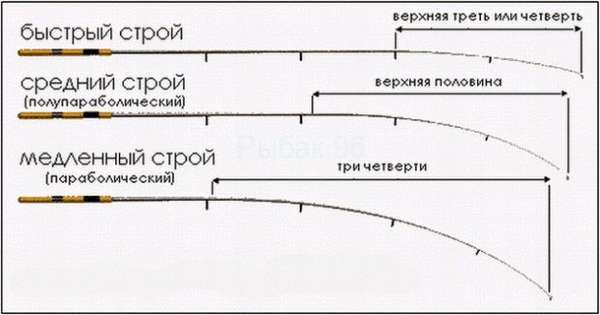
Schematic illustration and comparison of the difference in the structure of the rods.
It’s not easy to say how to choose the best feeder rod for beginners. The medium and fast action will allow you to cast with greater accuracy, fish for trophies more confidently and at the same time feel the fish by its effect on the blank. We can say that rods of this structure partially compensate for the mistakes often made by anglers with little experience in using such gear.
There is another type of system - complex, which behaved somewhat differently. It is called combined or progressive. The fact is that under ordinary statistical loads the behavior of the rod corresponds to that for a fast action. But, as they increase, the behavior of the blank changes and begins to correspond to a semi-parabolic, which, naturally, greatly helps in fishing.
This “smart” behavior of the rod greatly helps a beginner cope with catching trophy specimens. A form with similar characteristics is undoubtedly the best, but its cost is also the highest.
The cost indicators of the forms vary widely. The most budget-friendly feeder rods are fiberglass products made in China. They usually have a fast action. In the fishing community they were nicknamed "sticks" for their toughness.
Feeder structure
This characteristic shows how the rod bends under load. There are fast and slow builds. Typically, powerful and heavy feeders have a fairly high rigidity, so their structure can be called super-rigid. On the contrary, light rods have less rigidity. A fast action feeder bends at the top of the whip, while a slow action feeder bends at about 2/3 of the whip.
Each system has its own advantages and disadvantages. Fast action: the advantages include high casting range and resistance to current. One of the disadvantages is that it is more difficult to fish with a braided line. SalmoDiamondFeeder rods boast a fast action. Slow action: the advantages are additional shock absorption when fishing for violent fish and the possibility of using thin leashes in combination with braid. Disadvantages: high price.
Which rod design to choose?
In the practice of producing forms for feeder fishing, two main types are used: telescopic and plug-in. In addition to their structure, they also differ in physical qualities.
Forms of telescopic structure
These rods are popular for beginners because they are more attractive in both appearance and functionality:
- Telescopes are compact; when folded, they take up less space, which is convenient when traveling long distances to a fishing spot.
- They are lighter because the thickness of the link walls has significant limitations.
However, they have some negative aspects:
- limited test indicators, usually it does not exceed 80 grams, based on this indicator, you should drop up to 30 grams to be sure of the strength indicators,
- telescopes do not use reinforcing materials at the joints - this negatively affects the structure of the rod,
- the rings on such forms are installed exclusively at the ends of the retractable elbows; at other points they cannot be used by definition,
- It is very difficult to repair telescopic fishing rods - the main loads act on it precisely in the places where the rings are installed.
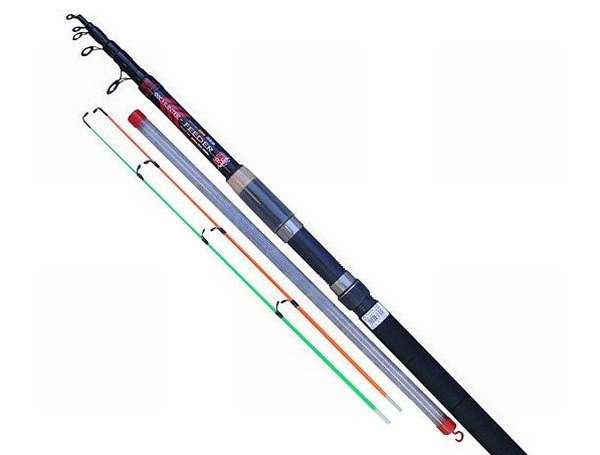
A telescopic feeder rod is convenient to use, but has a number of limitations in use.
A telescopic feeder can be made from an ordinary fishing rod of a similar design; this is the most budget option. But it should be taken into account that float forms are also characterized by a corresponding structure. In addition, the sales package does not include spare quivertypes with various tests.
The selected telescopic feeder rod must be subjected to a simple test before purchase:
- expand it to its full length,
- find the center of gravity of the form,
- shake him.
In this case, you need to make sure that there is no loosening of the rod at the joints. If play is felt in at least one joint, it is better to refuse such a purchase.
Plug feeders
Rods of this design are popular among fishing enthusiasts who have some experience in this noble activity.

Plug-type feeders allow for longer and more accurate casting.
Among the distinctive features of such forms are the following characteristics:
- Due to their plasticity, such blanks are able to withstand significant jerk loads, which allows you to reliably catch large fish.
- The action for a plug fishing rod can be selected from parabolic to medium, and this helps prevent its breakage and increases catchability.
- When using parabolic fishing rods with a parabolic action, the tackle can be cast to the maximum distance, since this involves the maximum length from the handle to the tip.
If a plug rod breaks, repair is problematic, since the guide rings are solidly fixed to the knees.
The limiting factor in the use of plugs is their high cost.
A beginner will most likely choose fast Chinese fiberglass, guided by its relatively low cost. With all its shortcomings, such a form can be very catchy, because it is not the fishing rod that catches the fish, but the angler. A savvy beginner will be able to adapt to the characteristics of his gear and use it with maximum efficiency for a particular case.
Quivertypes
This is a special part of the feeder rod, which is its characteristic distinguishing feature. It is a thin top of the form. Most models of such fishing rods come with two or three whips included in the sales package. They are not spares. These are independent replaceable parts designed to change the characteristics of the form when fishing conditions change. Thus, you can switch to fishing for other species simply by changing the quivertype.
Access rings
This element of the feeder rod design is intended for guiding the line or cord when casting. When using them, the most trouble is caused by their wear and tear from exposure to scaffolding. On low quality rods they cut right through in a relatively short time. Therefore, leading fishing tackle manufacturers install bushings made of various materials, such as ceramics or aluminum oxide, inside the rings.
In general, this element of feeder gear needs special attention. The fact is that river water always contains a lot of filamentous algae and poplar fluff, which are located on the surface in calm weather. Sticking to the cord or fishing line, they form a tight ball as they pass through the rings. When casting, it easily breaks the tip, getting stuck inside the tulip ring. Such a quivertype has to be replaced with a new one.
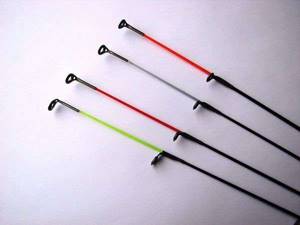
Feeder rod tips with guides.
Feeder rod equipment
No one has been able to choose universal gear, so you shouldn’t get your hopes up about this. The choice is made based on fishing conditions. These include:
- type of reservoir;
- the nature of the bottom;
- flow speed.
Based on these data, each fisherman chooses his own equipment elements. What does this mean?
- hooks;
- feeder;
- fishing line
Choosing a hook is quite simple. It depends on what kind of fish you plan to catch with it. A small hook will not support large fish, and a large one will not catch small prey. The most commonly used universal hooks are from 14 to 18 numbers.

The choice of fishing line is also simple. For feeder rods, a special fishing line with a diameter of no more than 0.3 millimeters is produced. Instead, a braided cord is suitable, which is somewhat stronger than fishing line. However, fishing line is the ideal material. It absorbs the jerks of the fish.
Feeder feeders are universal. They vary in shape; you can find round, square, oval, spring and others. The choice of feeder depends on the fishing conditions. If the current is strong, choose feeders with corners. There are also open and closed models. If the food is of plant origin, the feeder should be open, if the food is of animal origin, then closed. Metal models are stronger than plastic ones, but they are somewhat more expensive.
Budget feeder forms
DIY feeder stand
Fishing with this type of gear is becoming increasingly popular, so the market is overflowing with rods. Let's try to highlight the best ones in terms of price-quality ratio:
- The leading place in such a unique rating should rightfully be given to the manufacturer Mikado. His inexpensive products have always been of excellent quality. The best forms are about 3.5 meters long. He produces worse long ones, which are excessively heavy and have low sensitivity.
- The next representative of the legendary manufacturers of fishing products, distinguished in the manufacture of blanks, is Shimano. But to purchase such a fishing rod you need, at a minimum, to represent the middle class. The main material in production is carbon fiber, but recently the proportion of products made from geofiber has been increasing. Such rods are lighter in weight, while increasing sensitivity and flexibility.
- The Baltic manufacturer Salmo traditionally supplies the market with budget fishing rods under its own brand. Not having their own production, they organized the broadest cooperation, ordering components from related suppliers. At the same time, the quality of the rods from this supplier is traditionally quite decent.
- Banax Picolo feeder fishing forms, according to the manufacturer, were developed specifically for Russian conditions. All models of Banax rods are equipped with an additional insert, which allows you to change the characteristics of the rod in relation to specific fishing conditions during fishing. The material used in the production of forms of this brand is graphite, the material is light and durable.
- This list can also include products from the well-known manufacturer Daiwa. They offer a wide range of models from light to heavy professional-level fishing rods.
Review of the best models and their estimated cost
Having examined several popular models, we can draw a conclusion about them. The best models have gained popularity among fishermen for good reason.
- Shimano Beast Master Feeder model. Its length is 3.3 meters, this feeder is ideal for fishing in still water. Equipped with 15 rings, test 50 grams. The estimated cost will be about 10,000 rubles.
- Model Daiwa Vulcan X Leger. The rod is made of graphite, very durable. Test 60 grams, length 3.66 meters. The cost is very pleasing to many fishing enthusiasts. It is about 8500 rubles.
- Model Nautilus Vegan Feeder NVF. This rod is designed for medium and long distance fishing. There are 15 rings in total. The cost of a 4.1 meter long model with a dough weight of up to 80 grams will be approximately 9,800 rubles.
- The Team Salmo TOURNAMENT 100 model is produced in Latvia and is quite expensive. The quality of the product corresponds to the price. Performance characteristics are high. Length is 3.9 meters, test 100 grams. The rings of the model are lightweight. Excellent depreciation of the form. The cost of the model, including the Fuji reel seat, is 20,500 rubles.
In general, there are a huge number of feeder models on the market. The consumer has an excellent choice and very varied prices. A feeder is an excellent fishing rod, when choosing which you should not trust the seller or your fisherman friend. There are very specific parameters that will determine for a fisherman not only a high-quality model, but also one that is suitable for the required fishing conditions.
